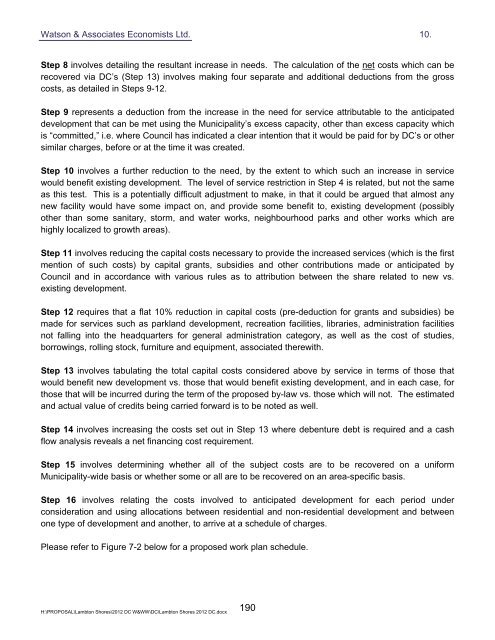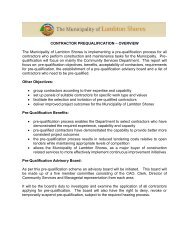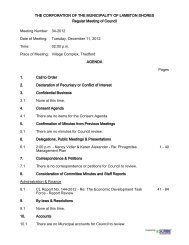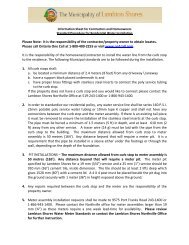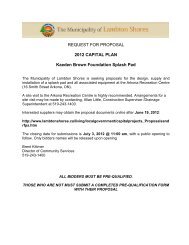View - The Municipality of Lambton Shores
View - The Municipality of Lambton Shores
View - The Municipality of Lambton Shores
Create successful ePaper yourself
Turn your PDF publications into a flip-book with our unique Google optimized e-Paper software.
Watson & Associates Economists Ltd. 10.<br />
Step 8 involves detailing the resultant increase in needs. <strong>The</strong> calculation <strong>of</strong> the net costs which can be<br />
recovered via DC’s (Step 13) involves making four separate and additional deductions from the gross<br />
costs, as detailed in Steps 9-12.<br />
Step 9 represents a deduction from the increase in the need for service attributable to the anticipated<br />
development that can be met using the <strong>Municipality</strong>’s excess capacity, other than excess capacity which<br />
is “committed,” i.e. where Council has indicated a clear intention that it would be paid for by DC’s or other<br />
similar charges, before or at the time it was created.<br />
Step 10 involves a further reduction to the need, by the extent to which such an increase in service<br />
would benefit existing development. <strong>The</strong> level <strong>of</strong> service restriction in Step 4 is related, but not the same<br />
as this test. This is a potentially difficult adjustment to make, in that it could be argued that almost any<br />
new facility would have some impact on, and provide some benefit to, existing development (possibly<br />
other than some sanitary, storm, and water works, neighbourhood parks and other works which are<br />
highly localized to growth areas).<br />
Step 11 involves reducing the capital costs necessary to provide the increased services (which is the first<br />
mention <strong>of</strong> such costs) by capital grants, subsidies and other contributions made or anticipated by<br />
Council and in accordance with various rules as to attribution between the share related to new vs.<br />
existing development.<br />
Step 12 requires that a flat 10% reduction in capital costs (pre-deduction for grants and subsidies) be<br />
made for services such as parkland development, recreation facilities, libraries, administration facilities<br />
not falling into the headquarters for general administration category, as well as the cost <strong>of</strong> studies,<br />
borrowings, rolling stock, furniture and equipment, associated therewith.<br />
Step 13 involves tabulating the total capital costs considered above by service in terms <strong>of</strong> those that<br />
would benefit new development vs. those that would benefit existing development, and in each case, for<br />
those that will be incurred during the term <strong>of</strong> the proposed by-law vs. those which will not. <strong>The</strong> estimated<br />
and actual value <strong>of</strong> credits being carried forward is to be noted as well.<br />
Step 14 involves increasing the costs set out in Step 13 where debenture debt is required and a cash<br />
flow analysis reveals a net financing cost requirement.<br />
Step 15 involves determining whether all <strong>of</strong> the subject costs are to be recovered on a uniform<br />
<strong>Municipality</strong>-wide basis or whether some or all are to be recovered on an area-specific basis.<br />
Step 16 involves relating the costs involved to anticipated development for each period under<br />
consideration and using allocations between residential and non-residential development and between<br />
one type <strong>of</strong> development and another, to arrive at a schedule <strong>of</strong> charges.<br />
Please refer to Figure 7-2 below for a proposed work plan schedule.<br />
H:\PROPOSAL\<strong>Lambton</strong> <strong>Shores</strong>\2012 DC W&WW\DC\<strong>Lambton</strong> <strong>Shores</strong> 2012 DC.docx<br />
190


